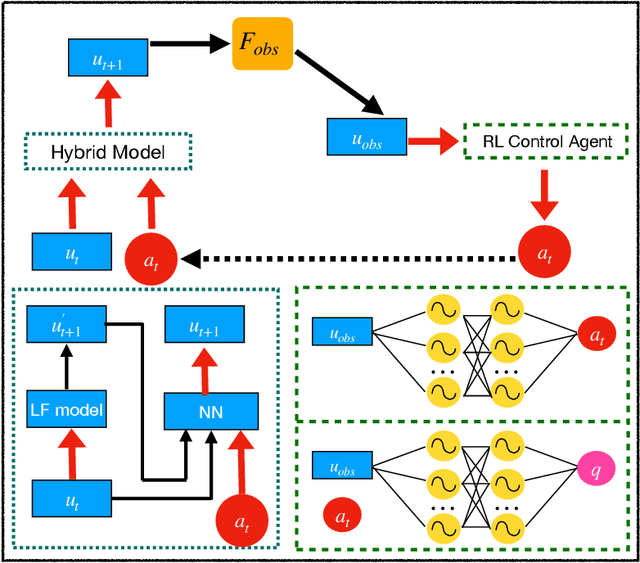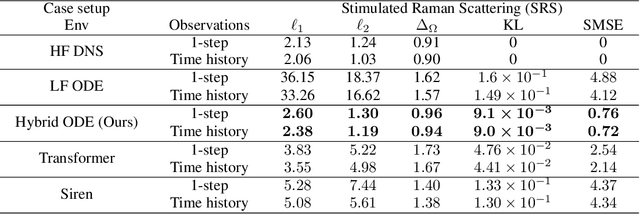Aditya Grover
MobileWorldBench: Towards Semantic World Modeling For Mobile Agents
Dec 16, 2025Abstract:World models have shown great utility in improving the task performance of embodied agents. While prior work largely focuses on pixel-space world models, these approaches face practical limitations in GUI settings, where predicting complex visual elements in future states is often difficult. In this work, we explore an alternative formulation of world modeling for GUI agents, where state transitions are described in natural language rather than predicting raw pixels. First, we introduce MobileWorldBench, a benchmark that evaluates the ability of vision-language models (VLMs) to function as world models for mobile GUI agents. Second, we release MobileWorld, a large-scale dataset consisting of 1.4M samples, that significantly improves the world modeling capabilities of VLMs. Finally, we propose a novel framework that integrates VLM world models into the planning framework of mobile agents, demonstrating that semantic world models can directly benefit mobile agents by improving task success rates. The code and dataset is available at https://github.com/jacklishufan/MobileWorld
Sparse-LaViDa: Sparse Multimodal Discrete Diffusion Language Models
Dec 16, 2025Abstract:Masked Discrete Diffusion Models (MDMs) have achieved strong performance across a wide range of multimodal tasks, including image understanding, generation, and editing. However, their inference speed remains suboptimal due to the need to repeatedly process redundant masked tokens at every sampling step. In this work, we propose Sparse-LaViDa, a novel modeling framework that dynamically truncates unnecessary masked tokens at each inference step to accelerate MDM sampling. To preserve generation quality, we introduce specialized register tokens that serve as compact representations for the truncated tokens. Furthermore, to ensure consistency between training and inference, we design a specialized attention mask that faithfully matches the truncated sampling procedure during training. Built upon the state-of-the-art unified MDM LaViDa-O, Sparse-LaViDa achieves up to a 2x speedup across diverse tasks including text-to-image generation, image editing, and mathematical reasoning, while maintaining generation quality.
From Masks to Worlds: A Hitchhiker's Guide to World Models
Oct 23, 2025Abstract:This is not a typical survey of world models; it is a guide for those who want to build worlds. We do not aim to catalog every paper that has ever mentioned a ``world model". Instead, we follow one clear road: from early masked models that unified representation learning across modalities, to unified architectures that share a single paradigm, then to interactive generative models that close the action-perception loop, and finally to memory-augmented systems that sustain consistent worlds over time. We bypass loosely related branches to focus on the core: the generative heart, the interactive loop, and the memory system. We show that this is the most promising path towards true world models.
PredGen: Accelerated Inference of Large Language Models through Input-Time Speculation for Real-Time Speech Interaction
Jun 18, 2025Abstract:Large Language Models (LLMs) are widely used in real-time voice chat applications, typically in combination with text-to-speech (TTS) systems to generate audio responses. However, their large size often leads to noticeable latency between the end of user input and the start of audio output, resulting in suboptimal user experiences. This latency is particularly evident when LLMs are deployed as single-user voice assistants on consumer-grade hardware with limited computing capacity. We discovered that this latency is primarily dominated by the time it takes for the LLMs to generate the first sentence, which is required as input by the TTS systems that synthesize audio responses on a sentence-by-sentence basis. To address this bottleneck, we propose Predictive Generation (PredGen), a novel framework that mitigates-or even eliminates-this delay through speculative decoding at input time. PredGen generates candidate responses while the user is still speaking, enabling the system to begin TTS processing with minimal delay. Simulated experiments on the Lmsys and MT-Bench datasets show that the proposed method can effectively reduce the latency by around 2x across a wide range of use cases, while incurring only minimal additional computation cost at input time-computation that would otherwise go unused.
OpenThoughts: Data Recipes for Reasoning Models
Jun 05, 2025Abstract:Reasoning models have made rapid progress on many benchmarks involving math, code, and science. Yet, there are still many open questions about the best training recipes for reasoning since state-of-the-art models often rely on proprietary datasets with little to no public information available. To address this, the goal of the OpenThoughts project is to create open-source datasets for training reasoning models. After initial explorations, our OpenThoughts2-1M dataset led to OpenThinker2-32B, the first model trained on public reasoning data to match DeepSeek-R1-Distill-32B on standard reasoning benchmarks such as AIME and LiveCodeBench. We then improve our dataset further by systematically investigating each step of our data generation pipeline with 1,000+ controlled experiments, which led to OpenThoughts3. Scaling the pipeline to 1.2M examples and using QwQ-32B as teacher yields our OpenThoughts3-7B model, which achieves state-of-the-art results: 53% on AIME 2025, 51% on LiveCodeBench 06/24-01/25, and 54% on GPQA Diamond - improvements of 15.3, 17.2, and 20.5 percentage points compared to the DeepSeek-R1-Distill-Qwen-7B. All of our datasets and models are available on https://openthoughts.ai.
LaViDa: A Large Diffusion Language Model for Multimodal Understanding
May 22, 2025Abstract:Modern Vision-Language Models (VLMs) can solve a wide range of tasks requiring visual reasoning. In real-world scenarios, desirable properties for VLMs include fast inference and controllable generation (e.g., constraining outputs to adhere to a desired format). However, existing autoregressive (AR) VLMs like LLaVA struggle in these aspects. Discrete diffusion models (DMs) offer a promising alternative, enabling parallel decoding for faster inference and bidirectional context for controllable generation through text-infilling. While effective in language-only settings, DMs' potential for multimodal tasks is underexplored. We introduce LaViDa, a family of VLMs built on DMs. We build LaViDa by equipping DMs with a vision encoder and jointly fine-tune the combined parts for multimodal instruction following. To address challenges encountered, LaViDa incorporates novel techniques such as complementary masking for effective training, prefix KV cache for efficient inference, and timestep shifting for high-quality sampling. Experiments show that LaViDa achieves competitive or superior performance to AR VLMs on multi-modal benchmarks such as MMMU, while offering unique advantages of DMs, including flexible speed-quality tradeoff, controllability, and bidirectional reasoning. On COCO captioning, LaViDa surpasses Open-LLaVa-Next-8B by +4.1 CIDEr with 1.92x speedup. On bidirectional tasks, it achieves +59% improvement on Constrained Poem Completion. These results demonstrate LaViDa as a strong alternative to AR VLMs. Code and models will be released in the camera-ready version.
WaterFlow: Learning Fast & Robust Watermarks using Stable Diffusion
Apr 18, 2025Abstract:The ability to embed watermarks in images is a fundamental problem of interest for computer vision, and is exacerbated by the rapid rise of generated imagery in recent times. Current state-of-the-art techniques suffer from computational and statistical challenges such as the slow execution speed for practical deployments. In addition, other works trade off fast watermarking speeds but suffer greatly in their robustness or perceptual quality. In this work, we propose WaterFlow (WF), a fast and extremely robust approach for high fidelity visual watermarking based on a learned latent-dependent watermark. Our approach utilizes a pretrained latent diffusion model to encode an arbitrary image into a latent space and produces a learned watermark that is then planted into the Fourier Domain of the latent. The transformation is specified via invertible flow layers that enhance the expressivity of the latent space of the pre-trained model to better preserve image quality while permitting robust and tractable detection. Most notably, WaterFlow demonstrates state-of-the-art performance on general robustness and is the first method capable of effectively defending against difficult combination attacks. We validate our findings on three widely used real and generated datasets: MS-COCO, DiffusionDB, and WikiArt.
d1: Scaling Reasoning in Diffusion Large Language Models via Reinforcement Learning
Apr 16, 2025Abstract:Recent large language models (LLMs) have demonstrated strong reasoning capabilities that benefits from online reinforcement learning (RL). These capabilities have primarily been demonstrated within the left-to-right autoregressive (AR) generation paradigm. In contrast, non-autoregressive paradigms based on diffusion generate text in a coarse-to-fine manner. Although recent diffusion-based large language models (dLLMs) have achieved competitive language modeling performance compared to their AR counterparts, it remains unclear if dLLMs can also leverage recent advances in LLM reasoning. To this end, we propose d1, a framework to adapt pre-trained masked dLLMs into reasoning models via a combination of supervised finetuning (SFT) and RL. Specifically, we develop and extend techniques to improve reasoning in pretrained dLLMs: (a) we utilize a masked SFT technique to distill knowledge and instill self-improvement behavior directly from existing datasets, and (b) we introduce a novel critic-free, policy-gradient based RL algorithm called diffu-GRPO. Through empirical studies, we investigate the performance of different post-training recipes on multiple mathematical and logical reasoning benchmarks. We find that d1 yields the best performance and significantly improves performance of a state-of-the-art dLLM.
Multi-fidelity Reinforcement Learning Control for Complex Dynamical Systems
Apr 08, 2025



Abstract:Controlling instabilities in complex dynamical systems is challenging in scientific and engineering applications. Deep reinforcement learning (DRL) has seen promising results for applications in different scientific applications. The many-query nature of control tasks requires multiple interactions with real environments of the underlying physics. However, it is usually sparse to collect from the experiments or expensive to simulate for complex dynamics. Alternatively, controlling surrogate modeling could mitigate the computational cost issue. However, a fast and accurate learning-based model by offline training makes it very hard to get accurate pointwise dynamics when the dynamics are chaotic. To bridge this gap, the current work proposes a multi-fidelity reinforcement learning (MFRL) framework that leverages differentiable hybrid models for control tasks, where a physics-based hybrid model is corrected by limited high-fidelity data. We also proposed a spectrum-based reward function for RL learning. The effect of the proposed framework is demonstrated on two complex dynamics in physics. The statistics of the MFRL control result match that computed from many-query evaluations of the high-fidelity environments and outperform other SOTA baselines.
When To Solve, When To Verify: Compute-Optimal Problem Solving and Generative Verification for LLM Reasoning
Apr 01, 2025Abstract:Scaling test-time compute has emerged as a key strategy for enhancing the reasoning capabilities of large language models (LLMs), particularly in tasks like mathematical problem-solving. A traditional approach, Self-Consistency (SC), generates multiple solutions to a problem and selects the most common answer via majority voting. Another common method involves scoring each solution with a reward model (verifier) and choosing the best one. Recent advancements in Generative Reward Models (GenRM) reframe verification as a next-token prediction task, enabling inference-time scaling along a new axis. Specifically, GenRM generates multiple verification chains-of-thought to score each solution. Under a limited inference budget, this introduces a fundamental trade-off: should you spend the budget on scaling solutions via SC or generate fewer solutions and allocate compute to verification via GenRM? To address this, we evaluate GenRM against SC under a fixed inference budget. Interestingly, we find that SC is more compute-efficient than GenRM for most practical inference budgets across diverse models and datasets. For instance, GenRM first matches SC after consuming up to 8x the inference compute and requires significantly more compute to outperform it. Furthermore, we derive inference scaling laws for the GenRM paradigm, revealing that compute-optimal inference favors scaling solution generation more aggressively than scaling the number of verifications. Our work provides practical guidance on optimizing test-time scaling by balancing solution generation and verification. The code is available at https://github.com/nishadsinghi/sc-genrm-scaling.
 Add to Chrome
Add to Chrome Add to Firefox
Add to Firefox Add to Edge
Add to Edge